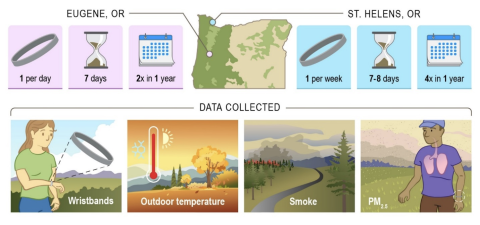Description
Understanding how chemical exposure varies with and between people over time is a critical component of characterizing the exposome—the totality of exposures over the lifespan. However, this remains an understudied aspect of exposomic research. Our objective was to investigate trends in variability for chemical exposure data between and within people.Thirty-five people in Eugene, Oregon and 46 people in St. Helens, Oregon wore silicone wristbands over multiple seasons, including a span of heavy wildfire smoke in Eugene. Each participant wore between 4 and 14 wristbands. We analyzed 586 wristbands for 94 and 58 chemicals in the Eugene and St. Helens studies, respectively. The same 43 polycyclic aromatic hydrocarbons (PAHs) were measured in both studies. We also evaluated three environmental variables for their impact on chemical concentrations. Generalized mixed effects models were fit to each chemical and variance partitioning was used to understand and quantify sources of variability across environmental factors and inter- and intra-individual variables. We observed PAHs that were consistent within people across different days. For a subset of these PAHs, results did not agree well between studies, indicating the importance of measuring chemical data at different time points across studies. Environmental variables were not sufficient for explaining data variability for most chemicals. Only 21% and 30% of the modeled chemicals for Eugene and St. Helens, respectively, had a combined environmental variable R2 at or above 0.1 for either the detection or concentration model. Yet, environmental factors still revealed valuable information; we observed higher combined R2 values for styrene, o-xylene, ethylbenzene, and phenanthrene in the Eugene detection model, which came from a combination of fine particulate matter and smoke density information. The high number of repeated measures, inclusion of environmental variables, and advanced statistical methods in this manuscript allowed us to reach several conclusions for future exposomic research.

